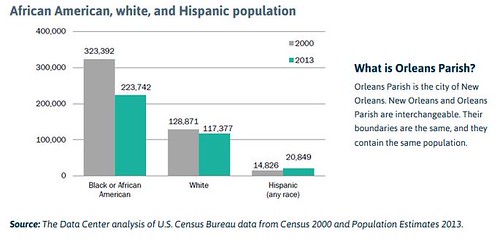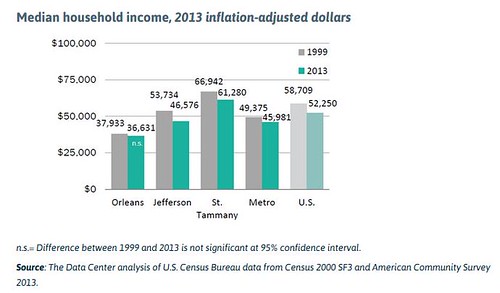The U.S. Census Bureau estimates that 1,240,977 residents were living in the New Orleans metro as of July 2013, a 4 percent increase from April 2010.[1] However, the metro area now has 93 percent of its 2000 population of 1,337,726. In this brief, we examine 2013 demographic data recently released by the U.S. Census Bureau and identify important changes in metro area parishes since 2000 (or the best benchmark available).Some of this stuff, you probably already know about. The racial breakdown of Orleans Parish has been closely reported ever since Katrina. The city has gone from being 66.7% black in 2000 to 59.1% in 2013. What gets less attention, though, is that as the city has become more white, the surrounding parishes have become less so. Jefferson is down from 65.4% to 54.7%. St. Bernard.. which used to be 84.4% (!) white is now down to 64.7%.
All of this, by the way, is a major reason Mary Landrieu is in so much trouble. This is the first time she's faced an off-year election without being able to count on overwhelmingly strong numbers out of New Orleans. Yes, she will win Orleans Parish in overwhelming fashion. But there aren't the total votes available there that she needs anymore.

Also of note in this report are the cost of living numbers. You may be surprised to learn that, since 1999, there is no significant difference in the median income in Orleans Parish.

Everything is relative, though. So taking into account that the surrounding parishes and *gasp* the entire US are showing declining incomes, New Orleans can still claim to be "bucking the trend" at least a little bit.
And yet in real numbers, median income is slightly down. Meanwhile the poverty rate in New Orleans is practically the same as it was in 1999 (27% as compared with 28%).
All of which means... the rent is too damn high.

Obviously, this leads to certain stresses.
High housing costs can limit a region’s ability to attract and retain the workforce essential for a healthy economy.[11] Severe housing cost burdens of more than 50 percent of household income indicate a serious problem in housing affordability. In 2004, the share of severely cost-burdened renters in New Orleans and the U.S. was 24 percent. In the nine years since, that share has spiked to 37 percent in Orleans while rising to only 26 percent nationally.So we've got a problem and it's a problem that is unique to our area. What are we doing about that? Well.. we are subsidizing the construction of more nice things for rich people.
Because gentrification is our official housing policy.
No comments:
Post a Comment